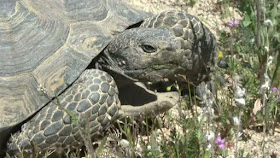 |
| Desert tortoise |
Spectrum News
CALIFORNIA CITY, Calif. — In the Mojave Desert, it’s not uncommon to see rabbits or even rattlesnakes slithering around but one reptile that’s harder to spot is the desert tortoise. But it turns out there are plenty of them in a protected area just an hour north of Palmdale, outside of California City. It’s called the Desert Tortoise Natural Area.
Video
“They are a long-lived species,” explained Jillian Estrada, preserve manager and conservation coordinator for the Desert Tortoise Preserve Committee.
“They can live more than 100 years in captivity. We actually see several tortoises out here that were initially tagged in the early 70s as part of a long-term study.”
We spotted one male tortoise that Estrada estimates is at least 40 to 50 years old. Her work with the DTPC focuses on protecting the long-lived reptile in the natural area.
“It’s about 39.5 square miles so just over 250,000 acres,” said Estrada.
The property was set up in the 1970s with the Bureau of Land Management and is filled with about 1,000 tortoises.
“They have inhabited the Mojave Desert for millions of years,” described Estrada. “They have been part of this ecosystem. They are specially adapted to survive here.”
But their survival is threatened by human settlements and a raven population that’s grown by 1500 percent over the last 30 years.
“They’re generalists, they’ll eat anything,” said Estrada. “They eat baby tortoises, adult tortoises, baby birds. They will eat lizards.”
A generous appetite threatening baby tortoises that don’t have a fully formed hard shell. It can be easy for predators, especially ravens, to peck through their brittle shells.
“As the mortality rate of juveniles has increased, in large part due to raven predation, we’re not seeing as many females surviving to reproductive age,” said Estrada.
The reproductive age for female tortoises is about 15 years old. However, the raven threat remains as those birds are protected under the Migratory Bird Act.
Tortoises that do survive, visitors can spot in the protected area but they cannot touch them. The animal – which is California’s state reptile – is protected at both the state and federal level.
Desert tortoises also hide out for about half the year.
“From late fall to early spring, about five to six months out of the year these guys are hibernating, which for these guys is called brumation,” said Estrada
When they’re not brumating, tortoises will dig shallow burrows, coming out to look for food. Visitors can learn more about their habits at an interpretive kiosk or explore four guided trails that total about 3.5 miles.
There’s also a full-time naturalist on-site from the middle of March to early-June to lead hikes and teach visitors about these gentle creatures.
The Desert Tortoise Natural Area is open daily from 8 a.m. to 5 p.m. and is free to the public.